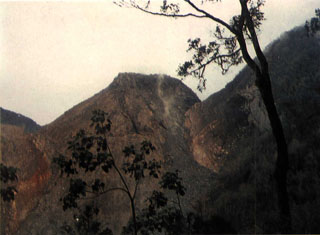Report on Ranakah (Indonesia) — March 1988
Scientific Event Alert Network Bulletin, vol. 13, no. 3 (March 1988)
Managing Editor: Lindsay McClelland.
Ranakah (Indonesia) Continued lava extrusion; large cloud; chemistry
Please cite this report as:
Global Volcanism Program, 1988. Report on Ranakah (Indonesia) (McClelland, L., ed.). Scientific Event Alert Network Bulletin, 13:3. Smithsonian Institution. https://doi.org/10.5479/si.GVP.SEAN198803-264071
Ranakah
Indonesia
8.637°S, 120.5302°E; summit elev. 2288 m
All times are local (unless otherwise noted)
The eruption continued through March. When surveyed in late February, the volume of the lava dome was ~ 11.5 x 106 m3; the lava tongue descending the N side of the lava dome had a volume of ~ 4.8 x 106 m3.
On 30 March at 0155, the crew of British Airways flight 11 (Singapore to Sydney) observed a large black cloud [over Indonesia] at 12.73°S, 119.30°E, roughly 450 km SSW of the volcano. The cloud was aligned N-S, well above the aircraft's 10 km flight level. A satellite image 25 minutes earlier showed a large convective cloud NE of the aircraft's position. However, a GMS image on 30 March at 0200, just after the aircraft observation, and others at 1100 on 29 and 30 March (NOAA 9 polar orbiter), showed heavy thunderstorm activity that can often both mimic eruption clouds and mask any that might be present. VSI observers reported that a large rockfall avalanche from the N side of the lava dome sent a glowing avalanche ~ 1.5 km down the Wai Reno valley on 30 March at 1930.
A hornblende pyroxene plagioclase andesite sample collected in late January was analyzed by the USGS using X-ray fluorescence.
Geological Summary. The Anak Ranakah (Child of Ranakah) lava dome was formed in 1987 in an area without previous recorded eruptions at the base of the large older lava dome of Gunung Ranakah. An arcuate group of lava domes extending about 12 km west from Gunung Ranakah to Poco Mandosawa occurs on the outer N flanks of the poorly known Poco Leok caldera on western Flores Island.
Information Contacts: VSI; J. Latter, DSIR Geophysics, New Zealand [info from NZ Meteorological Service]; O. Karst, SAB.

